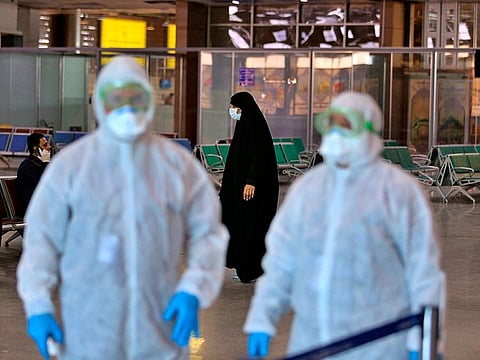Iran: 50 deaths from coronavirus, highest toll outside China
News agency reports 50 deaths in Qom since February 13

Dubai: Iran's semi-official ILNA news agency has reported on Monday that the death toll from the Covid-19 infection in the city of Qom has reached 50.
The report on Monday states that the 50 deaths were recorded in Qom, about 147km south west of the capital Tehran, since February 13. It's a big jump from the 12 deaths initially reported by Iran TV earlier on Monday.
Ahmad Amiriabadi Farahani, an official from Qom, said more than 250 are quarantined in the city — a popular destination for religious studies for Shiites from across Iran and other countries.
Also Read: Coronavirus cases spike in South Korea
Authorities shut down schools across much of the country for the second day.
Neighbouring countries also reported infections from travelers from Iran, prompting several countries to shut their borders to Iranian citizens.
How did coronavirus break out in Iran?
The outbreak in Iran has centered mostly on the city of Qom — but has spread rapidly over the past few days to people in at least four other cities, including the capital, Tehran, officials said.
Iranians went to the polls on Friday for a nationwide parliamentary elections, with many voters wearing masks and stocking up on hand sanitizer.
The outbreak in Iran has centered in the Shiite Muslim holy city of Qom. Officials said a merchant from the city who died of the Covid-19 infection used to regularly travel to China.
Flights were suspended between the two countries, but the trader reportedly used indirect flights.
Officials believe it's the merchant who brought the virus to Qom, roughly at the same time when many Shiite pilgrims from around the world are visiting the city's holy shrines. Qom in Iran's second-holiest city after Mashhad.
Pilgrims visit Qom's Fatimah Mesumeh shrine, considered one of the holiest sites among Shiites.
Quick spread
Since Iran reported its first case of the virus on Wednesday (February 19), pilgrims from Iran infected with the deadlly Covid-19 had been discovered as they were heading back to their countries.
Travellers infected with the virus from Iran were confirmed in Canada and Lebanon last week.
On February 22 (Saturday) the United Arab Emirates reported that an Iranian couple had been found infected with the virus.
On February 24 (Monday), Kuwait reported that three people returning from Iran were found with the virus, among them a Saudi national.
Bahrain reported a citizen returning from Iran had also been found to have the virus.
Neighbours close borders
Four immediate neighbours of the Islamic republic — Turkey, Pakistan, Afghanistan and Armenia — said on Sunday they would close land borders.
Three others imposed restrictions on air traffic, amid growing regional concerns about the spread of the virus.
Iraqi and Kuwaiti authorities have already banned travel to and from Iran. While Kuwait closed border crossing with Iraq as amny travel from Iran to Iraq then to Kuwait.
Rituals usually involve visiting holy shrines of Iran, then heading to Umrah in Saudi Arabia.
Saudi Arabia has ordered anyone traveling from Iran to wait at least 14 days before entering the kingdom as it seeks to prevent the spread of the virus to the Muslim pilgrimage sites of Mecca and Medina
Pilgrims are being quarantined in Kuwait and Bahrain as they arrive, another two flights are schedueled to land in Lebanon.
Preventive measures
Authorities have ordered the closure of schools, universities and other educational centres in 14 provinces across the country as a “preventive measure”.
Art events, concerts and film shows have been banned for a week.
“We are on the frontlines, we need help,” the head of Qom’s medical sciences university, Mohammadreza Ghadir, said on state television.
Sign up for the Daily Briefing
Get the latest news and updates straight to your inbox







